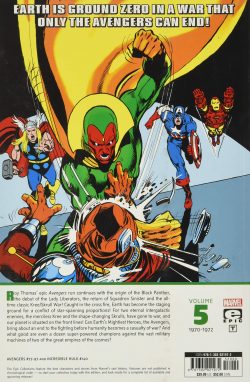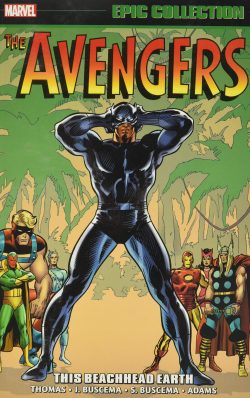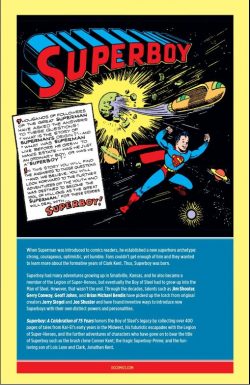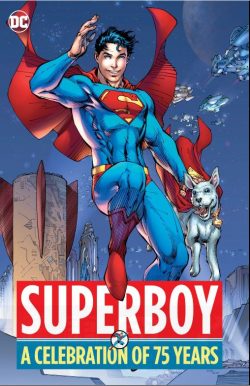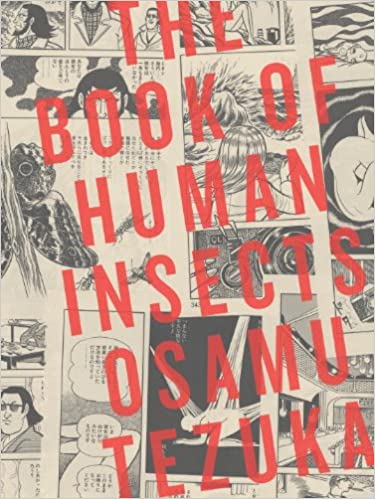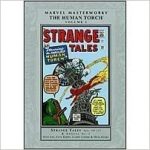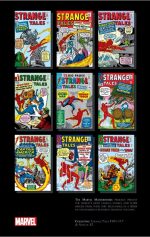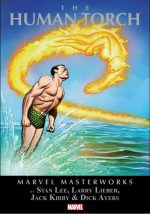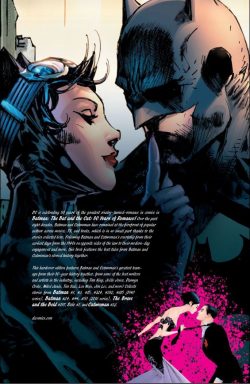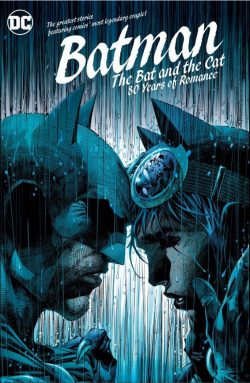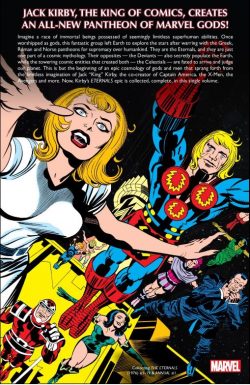

By Jack Kirby & various (Marvel)
ISBN: 978-1-3029-2200-9 (TPB)
Win’s Christmas Gift Recommendation: Monumental Marvel Magic for Movie-Oriented Fun Seekers… 9/10
Jack Kirby was – and remains – the most important single influence in the history of American comics. There are millions of words about what the man has done and meant, and you should read those if you are at all interested in our medium.
Naturally, I’m adding my own two-bobs’-worth, pointing out what you probably already know: Kirby was a man of vast imagination who translated big concepts into astoundingly potent and accessible symbols for generations of fantasy fans. If you were exposed to Kirby as an impressionable kid, he owns you for life. To be honest, the same probably applies whatever age you jump aboard the “Kirby Expressâ€â€¦
For those of us who grew up with Jack, his are the images which furnish our interior mindsets. Close your eyes and think “robot†and the first thing that pops up is a Kirby creation. Every fantastic, futuristic city in our heads is crammed with his chunky, towering spires. Because of Jack, we all know what the bodies beneath those stony-head statues on Easter Island look like, we’re all viscerally aware that you can never trust great big aliens parading around in their underpants and, most importantly, we know how cavemen dress and carnosaurs clash. Kirby’s creations are magical: they all inspire successive generations of creators to pick up the ball and keep running with it…
In the late 1930s, it took a remarkably short time for Kirby and his creative partner Joe Simon to become the wonder-kid dream-team of the newborn comic book industry. Together they produced a year’s worth of pioneering influential monthly Blue Bolt; dashed out Captain Marvel Adventures (#1) for overstretched Fawcett and – after Martin Goodman appointed Simon editor at Timely Comics – co-created a host of iconic characters such as Red Raven, the original Marvel Boy, Mercury, Hurricane, The Vision, Young Allies and of course million-selling mega-hit icon Captain America.
When Goodman failed to make good on his financial obligations, Simon & Kirby were snapped up by National/DC, who welcomed them with open arms and a fat chequebook. Bursting with ideas the staid company were never really comfortable with, the Dynamism Duo were initially an uneasy fit, and were given two moribund strips to play with until they found their creative feet: These were Sandman and Manhunter and they are an amazing feat of breathtaking bravura.
Both features turned both around virtually overnight and, once established, were parcelled off to studio staff as S&K switched to the “Kid Gang†genre they had pioneered at Timely. Joe ‘n’ Jack created wartime sales sensation Boy Commandos and Homefront iteration the Newsboy Legion, before being called up to serve in the war they had been fighting on comic pages since 1940.
Once demobbed, they returned to a very different funnybook business and soon left National to create their own little empire…
Simon & Kirby heralded and ushered in the first American age of mature comics – not just by inventing the Romance comic, but with all manner of challenging modern material about real people in extraordinary situations – before seeing it all disappear again in less than eight years.
Their small stable of magazines – generated for the association of companies known as Prize, Crestwood, Pines, Essenkay and/or Mainline Comics – blossomed and as quickly wilted when the industry abruptly contracted throughout the 1950s. After years of working for others, Simon & Kirby had finally established their own publishing house, producing comics for a far more sophisticated audience, only to find themselves in a sales downturn and awash in public hysteria generated by an anti-comicbook pogrom.
Hysterical censorship-fever spearheaded by US Senator Estes Kefauver and opportunistic pop psychologist Dr. Frederic Wertham led to witch-hunting Senate hearings. Caving in, publishers adopted a castrating straitjacket of draconian self-regulatory rules. Horror titles produced under the aegis and emblem of the Comics Code Authority were sanitised and anodyne affairs in terms of Shock and Gore, even though the market’s appetite for suspense and the uncanny was still high. Crime comics vanished and mature themes challenging an increasingly stratified and oppressive society were suppressed…
Simon quit the business for advertising, but Jack soldiered on, taking his skills and ideas to a number of safer, if less experimental, companies. As the panic abated, Kirby returned briefly to DC Comics where he worked on mystery tales and Green Arrow (at that time a mere back-up, page-filler in Adventure Comics and World’s Finest Comics) whilst concentrating on his long-dreamed-of newspaper strip Sky Masters of the Space Force.
During that period Kirby also re-packaged an original super-team concept that had been kicking around in his head since he and Joe had closed their studio. At the end of 1956, Showcase #6 premiered the Challengers of the Unknown…
After three more test issues the “Challs†won their own title with Kirby in command for the first eight issues. Then a legal dispute with Editor Jack Schiff exploded and the King was gone…
He found fresh fields and an equally hungry-for-change new partner in Stan Lee at ailing Atlas Comics (which had once been mighty Timely) and there created a revolution in superhero comics storytelling…
After just over a decade of never-ending innovation and crowd-pleasing wonderment, Kirby felt increasingly stifled. His efforts had transformed the little publisher into industry-pioneer Marvel but now felt trapped in a rut. Thus, he moved back to DC for another burst of sheer imagination and pure invention.
Kirby always understood the fundamentals of pleasing his audience and strived diligently to combat the appalling state of prejudice about the comics medium – especially from industry insiders and professionals who despised the “kiddies’ world†they felt trapped in.
After his controversial, grandiose Fourth World titles were cancelled, Kirby looked for other concepts which would stimulate his own vast creativity yet still appeal to a market growing evermore fickle. His follow-ups included science fiction themed heroes Kamandi and OMAC, supernatural stalwart The Demon, a run of war stories starring The Losers, and even a new Sandman, co-created with Simon, but although the ideas kept coming (Atlas, Kobra, Dingbats of Danger Street), yet again editorial disputes ended up with him leaving for promises of more creative freedom elsewhere…
Jack Kirby’s return to Marvel in 1976 was much hyped at the time but again turned out to be controversial. His new works and creations found friends rapidly, but his return to earlier creations Captain America and Black Pantherdivided the fanbase.
Kirby was never slavishly wedded to tight continuity, and preferred, in many ways, to treat his stints on titles as another “Day Oneâ€: a policy increasing at odds with the close-continuity demanded by a strident faction of the readership…
They were apparently blind to the unfettered, joyous freedom of imagination run wild, the majesty of pulse-pounding thrills and galvanising BIG ART channelling BIG IDEAS!
The end of the 1970s saw Kirby drift into animation: designing characters and scenarios for shows such as Turbo-Teen, Thundarr the Barbarian and even The New Fantastic Four. His comics efforts included graphic novel The Hunger Dogs and Super Powers for DC, and an adaptation of movie The Black Hole for syndicated strip Walt Disney’s Treasury of Classic Tales.
However, his most memorable move was to validate the newly-minted Independent Comics/Direct Sale Market sector where he launched bombastic sci fi shockers Captain Victory and the Galactic Rangers and Silver Star for distributor-turned-publisher Pacific Comics.
For Eclipse, he co-created with Steve Gerber the industry-excoriating symbol of creative rebellion Destroyer Duck (part of a grass-roots campaign that ultimately destroyed the iniquitous work-for-hire business model that had made creators little more than indentured servants for decades).
Let’s return to that final tenure at Marvel though. Despite his ideas frequently clashing with the company continuity, and being editorially sabotaged, his new ideas found an appreciative audience. 2001: A Space Odyssey, Devil Dinosaur and Machine Man broke new ground but his greatest and final contribution was undoubtedly his treatment of a contemporary crypto-science fad: The Eternals…
Now with a blockbuster Marvel movie just waiting on the shelf for punters to come watch it, the eccentric original feature has been squeezed into a trade paperback and digital Complete Collection (containing issues #1-20 and Eternals Annual#1 from June 1976 to January 1978), and is just crying out for you to come get it…
Written and drawn by Kirby withs inks by John Verpoorten, it all begins on ‘The Day of the Gods’, as anthropologist Doctor Damian and his daughter Margo are steered by mysterious guide Ike Harris through an incredible South American temple to discover that aliens inspired and educated the ancients…
Simultaneously, half a world away, diabolical monsters emerge from millennia of self-isolation to resume a war that spans the length of human existence…
And so begins a frantic scrabble as history is rewritten and humanity learns terrible truths: how giant aliens had visited Earth in ages past, sculpting proto-hominids into three distinct species: Human Beings; monstrous, genetically unstable Deviants and god-like super-beings who called themselves Eternals. Moreover, those humungous Space Gods have returned once again to check up on their experiment…
Remember Ike? His real name is Ikaris and he’s an Eternal monitoring how ‘The Celestials!’ will react as they set up to assess their experiment. As a country-sized ship enters Earth orbit, a cadre of mountain-sized aliens set up a monitoring station in the ruins, ignoring humanity, Deviants and Eternals alike, but the monstrous faction who once subjugated mankind and inspired most of our infernal mythology have resolved to destroy their creators whatever the cost…
The plan involve provoking humanity into rash attacks and their warlord Kro unleashes hell as ‘The Devil in New York!’Sadly for him and his vile minions, Ikaris has just left potentially orphaned Margo with capricious party-loving Sersi at her Manhattan apartment just in time to be truly ticked off by ‘The Night of the Demons!’
Mike Royer takes over as series inker with #5 as the solitary Eternals finally respond by having a committee meeting in their isolated citadel ‘Olympia!’ In the meantime, Sersi, Margo and Ikaris have been abducted to the Deviants’ undersea city, invoking a brutal response from warrior princess Thena, excitable speedster Makkari and a novel one from supreme Eternal Zuras who calls a press conference to explain Earth’s real history in ‘Gods and Men at City College!’
As ‘The Fourth Host’ take their mysterious measurements around the world, spy agency SHIELD infiltrates the Space God compound and almost triggers Armageddon, even as in Deviant Lemuria clandestine war within the ruling family endangers ‘The City of Toads’, while introducing two more tormented characters who fit no mould or definition.
The first is comely Ransak, and the other horrific Karkas: but which one is ‘The Killing Machine!’ too savage even for the Deviant arena?
The question remains unanswered as a curious Celestial invades the city in ‘Mother!’ sparking catastrophe and mass evacuation, even as the still-gathering Eternals debate their future in Olympia. The world’s doom-clock then jumps closer to midnight as the Soviets respond precipitately in ‘The Russians are Coming!’ just as the godly Eternals form a psychic gestalt to meet the Space Gods on more equal terms in ‘Uni-Mind!’
An extra-length diversion follows as The Eternals Annual #1 pits recently-relocated Ransak and Karkas against ‘The Time Killers’, after which the mind-blowing Story of Us resumes with human ‘Astronauts’ breaking into the Celestial orbiter, and proving an unreasonable response from the youngest Eternal and a forgotten colossus of human legend…
Presumably in response to publisher pressure, Kirby almost perpetrates a guest appearance from the mainstream Marvel Universe as a college experiment unleashes uncanny cataclysm in ‘Ikaris and the Cosmic Powered Hulk’: a brutal battle leaving the local environs a ‘Disaster Area’ and uncovering a lost terror of antiquity imprisoned in a subterranean ‘Big City Crypt’…
The awesome menace ignores the best the Eternals can muster, but ultimately falls to ‘Sersi the Terrible’, precipitating another crisis as sly, scheming Druig disregards the concerns of his fellow immortals and attempts ‘To Kill a Space God!’, before falling to the sheer determination of Ikaris in ‘The Pyramid’…
And then it stopped. Never a comfortable fit with the rest of the Marvel Universe, the comic explored Kirby’s fascinations with Deities, Space and Supernature through the lens of very human observers. Once the series ended and Kirby left, other creators greedily co-opted the concept – with mixed success – into the company’s mainstream continuity. The concept remade the greater continuity and there’s been duff and excellent reinterpretations ever since.
No matter their merits though, nothing has ever matched The King’s verve, passion or scope and scale…
This volume also includes unused art and covers, character designs, original art pages, pages of Kirby pencils, promotional house ads and editorial pages, plus a gallery of covers from previous collections.
Jack Kirby’s commitment to wholesome adventure, breakneck action and breathless wonderment, combined with his absolute mastery of the comic page and unceasing quest for the Next Big Thrill always makes for a captivating read. His comics should be compulsory for all and found in every home…
© 2020 MARVEL


